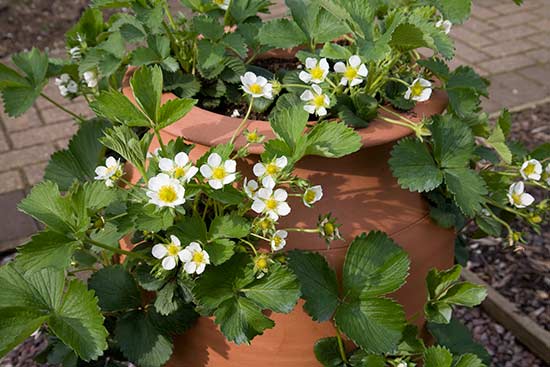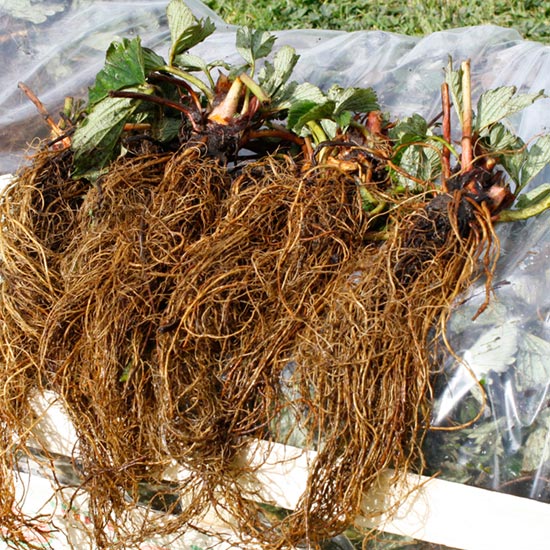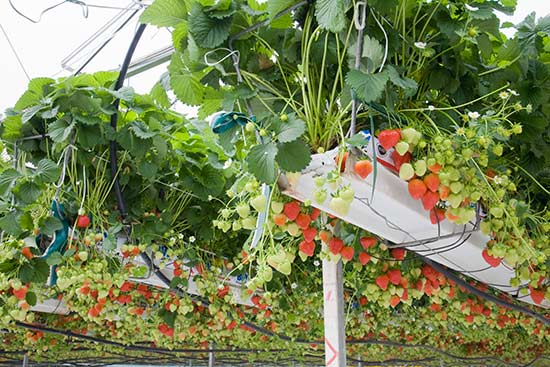Traditionally new strawberry beds were planted from fresh dug ‘runners’ whether taken from your own plants or purchased as bare root plants in October/November from a specialist nursery. Fresh dug runners are still widely planted but the drawback is that they are only available in October/November when the ground may not be in a particularly fit state for planting. The modern way to establish a new strawberry bed is to plant in the spring/early summer using coldstored (frozen) runners.
Coldstored runners are lifted in the winter when fully dormant and held at -1.8 degrees centigrade until required for planting. Once dormancy is broken by planting out in warm soils the plants will grow away very quickly and can produce a good crop within 60 days. Indeed, this is how 99% of commercial growers now grow their strawberries.
If you haven’t planted coldstored strawberry plants before, you may be alarmed by their appearance when you first receive them as they have very few or no leaves and show little sign of life. Don’t be fooled by first appearances though as once planted the new leaves will emerge within a few days and you will find that flowers start to appear within two to four weeks which is very exciting.
60-day Strawberries & the advantage of coldstored strawberry plants
The original reason behind the development of the 60 day strawberry was for strawberry growers to be able to bridge the strawberry production gap of mid-July to mid-August between the summer fruiting varieties and the later everbearing (perpetual) varieties. Commercial growers therefore aim to plant their 60 day plants between 10th May and the end of May when the weather is fairly warm. Incidentally, if you plant earlier when the weather is cooler production will take longer than 60 days but you will get a heavier crop and if you plant later production will start in less than 60 days but the crop and fruit size will be reduced. You will be able to buy 60 day (coldstored) plants from Pomona Fruits between March and early July and this will enable you to choose exactly when to plant them.
Commercial growers looking to produce the largest 60 day crop will plant grade A+ runners (with a crown size of 15-18mm) as the best performing varieties will produce 200-250g per plant in the first season and 750g per plant the following year. This is two to three times the amount of fruit you could expect to harvest from standard-grade plants in the first season. However, only a limited number of varieties are available as grade A+ plants. To achieve the best results in the garden (or allotment), always buy your strawberry plants from a reputable supplier such as Pomona Fruits. We only supply guaranteed certified disease-free plants. SuperCrowns are offered to the home gardener as the equivalent to grade A+ plants.

The first flowers will appear 2 to 4 weeks after planting coldstored strawberry plants.
Growing your coldstored strawberry plants
Soil requirements
Where should you grow your strawberries? If you have plenty of ground which will allow crop rotation – such as an allotment or large vegetable plot – you will be able to grow large crops over a good part of the summer. However, it is important to understand that strawberries may succumb to soil-borne diseases and these diseases once in the soil will stay there for some time. This will mean that once you have grown strawberries in the open ground you are going to have to plant the next lot in some fresh ground which has not grown strawberries for at least five years. Incidentally, strawberries will grow in any soil except the chalkiest.
Growing strawberries on a raised bed
The preferred method of growing in the ground is by the use of raised beds and this has a considerable number of advantages – raised beds provide good drainage, they allow roots to grow deeper, they are easy to manage and they can provide earlier crops. Raised beds are easy to construct – simply mark out a bed some 60cm (2ft) wide and whatever length you have room for and dig it out well adding plenty of well-rotted farmyard manure or garden compost leaving a raised ridge 7.5-10cm (3-4in) high in the centre. The raised bed should then be covered with black polythene sheeting with the edges well anchored into the ground. Ideally before laying the polythene sheeting you should lay a watering medium such as a hose with holes in it or a conventional drip line as this will help provide good, consistent watering. However, if you have neither don’t worry as you can cut a number of watering holes in the sheeting so that you can apply the water externally.
Planting is now simple as the plants should be planted through slits cut into the sheeting at around 30cm (12in) apart leaving around 75cm (30in) between the rows. This polythene will provide a number of benefits – no weeds, a good mulch when the berries are ripening to prevent soil damage, a warming effect during blossoming and ripening and general tidiness. To achieve an earlier crop you can use a tunnel cloche over a row or part of a row. Place the cloche over the plants in early spring, but remove or roll up the sides when the plants are flowering to give pollinating insects access.
Planting strawberry runners requires a little care for good results. Always plant them so that the roots hang downwards and the crown is exactly on the surface – never plant the runner with the crown buried or overexposed.
Growing strawberries in pots, hanging baskets and growbags
You can also grow strawberries in pots, hanging baskets and growbags. You can grow strawberries very effectively in growbags on table like structures as the commercial growers generally do and this is known as tabletop growing. This method of cultivation is described in detail in our blog, ‘Growing Tabletop Strawberries‘.

Commercial growers maximise the yield of the 60 day crop by planting runners that have a crown size of 15mm or more in diameter.
Maintenance of your coldstored strawberry plants
Maintenance wise strawberries are easy to look after. Perhaps the most important thing to do is to regularly remove any weeds that are growing as these can deprive plants of water in dry weather and harbour pests; also remove any leaves that have turned brown. Water the plants once they have flowered to encourage fruit growth but only water sparsely before flowering unless conditions are very dry because if you water too early you will encourage too much leafy growth.
If frosty conditions are forecast during flowering cover the plants with fleece, old curtains etc. and this should prevent the flowers from becoming frosted.
Once they are growing well your plants will produce runners and you should always remove them as they can seriously weaken the plants. As the fruits begin to ripen on plants grown in the open ground (where you have not used polythene sheeting) you will need to lay some form of mulch to keep the fruit clean and help minimise damage from slugs and snails. Barley straw is the usual and best mulch but if you cannot obtain it pieces of polythene sheeting are an acceptable substitute. Pick the strawberries as often as they are ripe and do not let overripe berries remain on the plants as this encourages the growth of mildews and moulds.
Post-harvest care
As soon as the strawberry plants have fruited you should cut off all leaves as close as you can to the crown without damaging it and this will enable the plants to build up for the following year’s crop. In the case of plants growing in open ground the new leaves that are produced will keep the plant growing and then be removed after cropping the next year but in the case of container and growbag grown plants the leaves should again be cut off in February and the new leaves will help the plants produce the next crop.
Strawberry plants will not last much longer than three years before they deteriorate and at the end of this period you should replace them with fresh stock. In the case of strawberries grown in containers the plants should be removed in each spring and should be replanted in fresh compost having removed a little of the old rooting system to stimulate new growth.
Feeding requirements
Feeding should not be necessary in the first year in plants grown in the ground and after that should only have a sprinkling of sulphate of potash each February. In the case of container and growbag grown plants you will need to apply a liquid feed that is high in potash at regular intervals once the plants have flowered. Empathy Grow Your Own Seaweed Fertiliser or a good tomato fertiliser should do the job well. Once plants in containers and growbags have fruited you should apply some blood, fish and bone to help the plants produce new growth.

Commercial strawberry production on a tabletop system.
Recommended varieties of coldstored strawberry plants
The following varieties are highly recommended for growing as 60 day (coldstored) plants and for best results in the first season you should consider (where possible) planting ‘SuperCrowns’ as these are the equivalent to the grade A+ plants supplied to commercial growers:
- 🍓 Elegance is a fairly new strawberry which produces very heavy crops of large red berries which have a wonderful sweet strawberry taste. This is one of the heaviest cropping strawberries around.
- 🍓 Fenella is a modern heavy cropping late summer fruiting strawberry. The berries are a glossy red and have a superb and distinctive sweet flavour and are mildly aromatic. Trials have shown that this variety has good resistance to verticillium wilt and crown rot and the fruits are able to tolerate heavy rain.
- 🍓 Florence is another late summer fruiting strawberry which is very popular with the home gardener due to its superb flavour and its outstanding resistance to pests and diseases. Cropping is heavy and the dark red berries are large with a very good flavour.
- 🍓 Malwina is a fabulous tasting strawberry and is very easy to grow along with being very disease resistant. The berries when ripe have a superb aroma and exceptionally sweet taste. Perfect for growing at home.
- 🍓 Malling Allure is a splendid strawberry bred by East Malling Research with a season 14 days later than Malling Centenary. The orange-red berries are juicy and wonderfully sweet, with superb fruit quality. Plants are heavy-yielding and have good resistance to powdery mildew, making this variety an excellent choice for extending the strawberry season in your garden.
- 🍓 Malling Centenary is a remarkable strawberry bred by East Malling Research to mark the research station’s 100th anniversary in 2013. The plants produce heavy crops of juicy berries with high sugar levels and an excellent strawberry flavour. This variety combines outstanding taste with a good shelf life, making it perfect for the home garden.
- 🍓 Vibrant is an excellent early variety to start the strawberry season. Bred by East Malling Research, it produces medium to large bright red berries that are very sweet and rich in flavour. The plants crop heavily and show good resistance to powdery mildew and crown rot. In years with cooler July temperatures, Vibrant can produce a surprising second crop in September with very good fruit quality.
Pomona Fruits
8th May 2025
